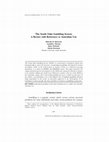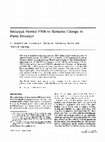Papers by Malcolm Battersby

BMJ case reports, 2009
This case describes the use of innovative person-centred motivational behaviour change tools to e... more This case describes the use of innovative person-centred motivational behaviour change tools to enhance chronic condition self-management with a person with chronic paranoid schizophrenia, significant drug abuse and multiple psychosocial issues. In standard care, the complexity of this patient's presentation, their cognitive impairment level and history of violence would likely exclude them from many therapies and treatment programs as unsuitable or in the "too hard" basket. In fact, using a motivational and highly person-centred approach proved to be extremely necessary and rewarding for the person and their mental health worker. This approach provided a clear structure, actual tools and a clear rationale for what many would argue, yet is often ill-defined, was "just good clinical practice". However, it also facilitated the development of "something special" in the relationship between the person and their worker that is central to person-centred c...

Journal of gambling studies / co-sponsored by the National Council on Problem Gambling and Institute for the Study of Gambling and Commercial Gaming, 2002
The South Oaks Gambling Screen (SOGS) is a psychometric instrument widely used internationally to... more The South Oaks Gambling Screen (SOGS) is a psychometric instrument widely used internationally to assess the presence of pathological gambling. Developed by Lesieur and Blume (1987) in the United States of America (USA) as a self-rated screening instrument, it is based on DSM-III and DSM-III-R criteria. This paper describes the origins and psychometric development of the SOGS and comments critically in relation to its construct validity and cutoff scores. Reference is made to the use of the SOGS in the Australian setting, where historically gambling has been a widely accepted part of the culture, corresponding to one of the highest rates of legaliZed gambling and gambling expenditure in the world. An alternative approach to the development of an instrument to detect people who have problems in relation to gambling is proposed.

In the Pursuit of Winning, 2008
Cognitive-Behaviour Therapy (CBT) is considered the number one nonpharmacological treatment for a... more Cognitive-Behaviour Therapy (CBT) is considered the number one nonpharmacological treatment for a number of mental and psychological disorders ). While CBT with problem gamblers has shown promise, the quality of the research in this area is lacking. One area of concern is that across the many trials and reports using CBT with gamblers no single unified approach has been used and so comparison across studies is limited. Similarly, translation of the CBT research into clinical practice is almost entirely absent . This article will explore the concepts of CBT with problem gamblers and identify common elements across all reported approaches. A unified model of CBT with problem gamblers will be suggested and the direct clinical application of this model described from a state-wide gambling service in Australia (Flinders Approach) with 205 problem gamblers. The results indicate that the Flinders Approach is successful in treating gamblers considered to be at the severest end of the experience, with a 69% completion rate. Implications for future research in which this model may be tested against other therapies and pharmacological treatments will be discussed.
Milbank Quarterly, 2007
SA HealthPlus, one of nine national Australian coordinated care trials, addressed chronic illness... more SA HealthPlus, one of nine national Australian coordinated care trials, addressed chronic illness care by testing whether coordinated care would improve health outcomes at the cost of usual care. SA HealthPlus compared a generic model of coordinated care for 3,115 intervention patients with the usual care for 1,488 controls. Service coordinators and the behavioral and care-planning approach were new. The health status (SF-36) in six of eight projects improved, and those patients who had been hospitalized in the year immediately preceding the trial were the most likely to save on costs. A mid-trial review found that health benefits from coordinated care depended more on patients' self-management than the severity of their illness, a factor leading to the Flinders Model of Self-Management Support.

Journal of Gambling Studies, 2010
There is a need to establish reliability and the various forms of validity in all measures in ord... more There is a need to establish reliability and the various forms of validity in all measures in order to feel confident in the use of such tools across a wide diversity of settings. The aim of this study is to describe the reliability and validity of the Victorian Gambling Screen (VGS) and in particular one of the sub-scales (Harm to Self-HS) in a specialist problem gambling treatment service in Adelaide, Australia. Sixty-seven consecutive gamblers were assessed using a previously validated clinical interview and the VGS (Ben-Tovim et al., The Victorian Gambling Screen: project report. Victorian Research Panel, Melbourne, 2001). The internal consistency of the combined VGS scales had a Cronbach's alpha of .85 with the HS scale .89. There was satisfactory evidence of convergent validity which included moderate correlations with another measure of gambling-the South Oaks Gambling Screen. There were also moderate correlations with other measures of psychopathology. Finally, how the VGS may best be used in clinical settings is discussed.

Journal of Gambling Studies, 2007
General Practitioners (GPs) are well placed to identify problem gamblers and provide early interv... more General Practitioners (GPs) are well placed to identify problem gamblers and provide early intervention. To date there is no evidence to suggest that GP's are routinely screening patients for potential gambling problems. This paper discusses the prevalence of problem gambling, the links with other health problems and ways that GPs can assist. Results from a pilot project that provided educational resources to GPS are also discussed. Suitable screening tools are available that could easily be used by GPs to assess the possibility of gambling problems in patients who may be at increased risk but do not seek help. Early identification and intervention may help prevent a gambling habit escalating to a serious problem. More work needs to be done to increase awareness with GPs of the extent of problem gambling in our community and to alert patients to the fact that gambling can affect their health and that GPs can help.
Journal of Gambling Studies, 2008
This case report of a 31 year old woman who described her main problem as an uncontrollable urge ... more This case report of a 31 year old woman who described her main problem as an uncontrollable urge to gamble on electronic gaming machines describes the application of exposure therapy (ET) by videoconferencing and the use of a clinical therapy assistant in the treatment of pathological gambling. The case study is used to demonstrate the effectiveness of this treatment with six sessions of therapy and 4 year follow up. The use of videoconferencing is discussed in relation to treatment effectiveness, ongoing follow up for the client and education and support for a community mental health nurse, therapy assistant, in a rural setting in South Australia. The implications of using this modality for the treatment of rural patients with problem gambling is discussed.
International Journal of Stroke, 2009

International Journal of Social Psychiatry, 2007
Less than optimal outcomes and escalating costs for chronic conditions including mental illness h... more Less than optimal outcomes and escalating costs for chronic conditions including mental illness have prompted calls for innovative approaches to chronic illness management. This study aimed to test the feasibility and utility of combining a generic, clinician administered and peer-led self-management group approach for people with serious mental illness. General practitioners and mental health case managers used a patient-centred care model (the Flinders model) to assist 38 patients with serious mental illness to identify their self-management needs, and match these with interventions including Stanford peer-led, self-management groups and one-to-one peer support. Self-management and quality of life outcomes were measured and qualitative evaluation elicited feedback from all participants. Collaborative care planning, combined with a problems and goals focused approach, resulted in improved self-management and mental functioning at 3 to 6 months follow-up. The Stanford self-management course was applicable and acceptable to patients with serious mental illnesses. Qualitative feedback was highly supportive of this approach. Generic, structured assessment and care planning approaches, resulting in self-management education targeted to the individual, improved self-management and quality of life. Patients and service providers reported considerable gains despite the challenges associated with introducing a generic model within the mental health and general practice sector.
International Journal of Mental Health Nursing, 2002
The training and outcomes for a mental health nurse, who completed a 6-month nurse behavioural ps... more The training and outcomes for a mental health nurse, who completed a 6-month nurse behavioural psychotherapy course at Flinders Medical Centre (Bedford Park, South Australia) is described. Completion of this course enabled the nurse to work mainly with pathological gamblers as a trainee nurse behaviour therapist. Her experience demonstrates that with appropriate training and supervision, mental health nurses are able to increase their knowledge base in specialist areas and gain skills in therapies that will allow them to work autonomously with clients. A brief description of the training, outcome of patient case management and skills acquisition achieved through training is presented.
Australian and New Zealand Journal of Mental Health Nursing, 2000

International Journal of Mental Health and Addiction, 2012
An innovative pilot treatment program was developed for problem gamblers living in rural areas of... more An innovative pilot treatment program was developed for problem gamblers living in rural areas of Australia using cognitive behaviour therapy (CBT) modified from an established specialist therapy service. The standard 12 weekly group program was delivered on site by adapting it to two 1 week blocks with daily group sessions and 1 week of patient practice between the face to face group sessions. The median SOGS score (8) met the cut off for probable pathological gambling at assessment. All 7 who were assessed as suitable for the program completed the treatment with the median SOGS score of 0 at the end of treatment indicating these clients were no longer pathological gamblers. This was maintained at 12 months for 5 clients who provided follow up measures. Participants experienced a clinically significant change in the severity of their gambling and its impacts. This pilot program proved to be acceptable to rural participants and provides preliminary evidence that this intervention can reduce gambling and improved life functioning. Randomised controlled designs are needed to confirm the efficacy of this treatment approach. This program may provide a model for the treatment of gambling clients with complex co-morbidities in other rural settings.

International Journal of Mental Health and Addiction, 2006
This study aimed to describe the 12-month period prevalence and risk factors for suicidal ideatio... more This study aimed to describe the 12-month period prevalence and risk factors for suicidal ideation and behaviour in a cohort of patients with pathological gambling attending a treatment service. Seventy-nine people with a diagnosis of pathological gambling received a mail out survey that included questions on postulated risk factors for suicidal ideation and behaviour, the modified Suicide Ideation Scale (SIS), the South Oaks Gambling Screen (SOGS), the Beck Depression Inventory (BDI) and the CAGE. A total of 54.4% of the surveys were returned completed. There were 81.4% who showed some suicidal ideation and 30.2% reported one or more suicide attempts in the preceding 12 months. Suicidal ideation and behaviours were positively correlated with the gambling severity (SOGS scores), the presence of debt attributed to gambling, alcohol dependence and depression (BDI). Suicidal ideation/behaviour was not significantly associated with gender and living arrangements, nor a history of receiving treatment for depression during the preceding 12 months. People with pathological gambling attending a treatment service had higher levels of suicidal ideation and behaviour than previous studies. Pathological gambling should be seen as a chronic condition with a similar risk for suicidal ideation and behaviour as other mental illnesses. Counselling services, general practitioners and mental health services should screen for gambling problems when assessing risk after suicide Int attempts and for suicide risk in patients presenting with gambling problems and co-morbid depression, alcohol abuse and a previous suicide attempt.
International Journal of Mental Health and Addiction, 2011
Problem gambling has become a widespread problem following the rapid expansion of electronic gami... more Problem gambling has become a widespread problem following the rapid expansion of electronic gaming machines into hotels and clubs over the last 10 years. Recent literature indicates that certain factors can influence problem gambling severity, such as psychiatric co-morbidity and personality traits, gambling related cognitions, substance use and gender. This study investigated 127 treatment seeking problem gamblers at baseline, who completed

Contemporary Clinical Trials, 2011
The prevalence of older Australians with multiple chronic diseases is increasing and now accounts... more The prevalence of older Australians with multiple chronic diseases is increasing and now accounts for a large proportion of total health care utilisation. Chronic disease self-management support (CDSMS) has become a core service component of many community based health programs because it is considered a useful tool in improving population health outcomes and reducing the financial burden of chronic disease care. However, the evidence base to justify these support programs is limited, particularly for older people with multiple chronic diseases. We describe an ongoing trial examining the effectiveness of a particular CDSMS approach called the Flinders Program. The Flinders Program is a clinician-led generic self-management intervention that provides a set of tools and a structured process that enables health workers and patients to collaboratively assess self-management behaviours, identify problems, set goals, and develop individual care plans covering key self-care, medical, psychosocial and carer issues. A sample of 252 older Australians that have two or more chronic conditions will be randomly assigned to receive either CDSMS or an attention control intervention (health information only) for 6 months. Outcomes will be assessed using self-reported health measures taken at baseline and post-intervention. This project will be the first comprehensive evaluation of CDSMS in this population. Findings are expected to guide consumers, clinicians and policymakers in the use of CDSMS, as well as facilitate prioritisation of public monies towards evidence-based services.

Chronic Illness, 2009
Governments and the medical profession are concerned that there continues to be less than optimal... more Governments and the medical profession are concerned that there continues to be less than optimal health outcomes despite escalating expenditure on health services from the effect of the ageing population with chronic illnesses. In this context, doctors will need to have knowledge and skills in effective chronic condition management (CCM) and chronic condition self-management (CCSM). A national workshop of representatives of eight medical schools from the CCSM special interest group (SIG) of the Australian and New Zealand Association on Medical Education met in September 2004, to consider curriculum content in CCM and CCSM. The workshop recommended that the Committee of Deans of Australian Medical Schools and the Commonwealth Department of Health and Ageing consider the identification and possible development of a specific curriculum for CCM and CCSM within the curricula of Australian Medical Schools. Consideration needs to be given to the changing nature of medical practice and that as part of this; doctors of the future will need skills in team participation, continuity of care, self-management support and patient-centered collaborative care planning. Doctors will also need skills to assist patients to better adhere to medical management, lifestyle behaviour change and risk factor reduction, if optimal health outcomes are to be achieved and costs are to be contained.
BMC Musculoskeletal Disorders, 2010
Background: Musculoskeletal disorders are common and costly disorders to workers compensation and... more Background: Musculoskeletal disorders are common and costly disorders to workers compensation and motor accident insurance systems and are a leading contributor to the burden of ill-health. In Australia, vocational rehabilitation is provided to workers to assist them to stay in, or return to work. Self-management training may be an innovative addition to improve health and employment outcomes from vocational rehabilitation.

Biological Psychiatry, 1996
This study investigated event-related potential (ERP) indices of information processing in suffer... more This study investigated event-related potential (ERP) indices of information processing in sufferers of panic disorder (PD). ERPs were recorded from 14 PD patients and 15 controls during an auditory target detection task. The task required subjects to discriminate infrequent target tones (p = .14; 2000 Hz) from frequent (p = . 72; 1000 Hz) and infrequent (p = .14; 500 Hz) distractor tones. A frontal P300 (P3a) identified in the PD group was characteristic of activity that would be expected to novel, task-irrelevant stimuli and is consistent with functional pathology involving the prefrontal-limbic pathways. This study provides psychophysiological evidence of an abnormality in PD of the brain's processing of physical changes in the stimulus field that occurs even under conditions of low stimulus load. It may assist in helping to understand the breakdown in information processing that occurs in PD under high load conditions such as crowds and supermarkets.

Australian Health Review, 2008
The Sharing Health Care SA chronic disease self-management (CDSM) project in rural South Australi... more The Sharing Health Care SA chronic disease self-management (CDSM) project in rural South Australia was designed to assist patients with chronic and complex conditions (diabetes, cardiovascular disease and arthritis) to learn how to participate more effectively in the management of their condition and to improve their self-management skills. Participants with chronic and complex conditions were recruited into the Sharing Health Care SA program and offered a range of education and support options (including a 6-week peer-led chronic disease self-management program) as part of the Enhanced Primary Care care planning process. Patient self-reported data were collected at baseline and subsequent 6-month intervals using the Partners in Health (PIH) scale to assess self-management skill and ability for 175 patients across four data collection points. Health providers also scored patient knowledge and self-management skills using the same scale over the same intervals. Patients also completed a modified Stanford 2000 Health Survey for the same time intervals to assess service utilisation and health-related lifestyle factors. Results show that both mean patient self-reported PIH scores and mean health provider PIH scores for patients improved significantly over time, indicating that patients demonstrated improved understanding of their condition and improved their ability to manage and deal with their symptoms. These results suggest that involvement in peer-led self-management education programs has a positive effect on patient self-management skill, confidence and health-related behaviour.






Uploads
Papers by Malcolm Battersby